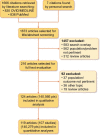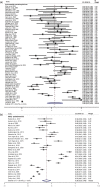Sleep apnoea syndrome prevalence in chronic kidney disease and end-stage kidney disease patients: a systematic review and meta-analysis
- PMID: 38186876
- PMCID: PMC10768783
- DOI: 10.1093/ckj/sfad179
Sleep apnoea syndrome prevalence in chronic kidney disease and end-stage kidney disease patients: a systematic review and meta-analysis
Abstract
Background: Several studies have examined the frequency of sleep apnoea (SA) in patients with chronic kidney disease (CKD), reporting different prevalence rates. Our systematic review and meta-analysis aimed to define the clinical penetrance of SA in CKD and end-stage kidney disease (ESKD) patients.
Methods: Ovid-MEDLINE and PubMed databases were explored up to 5 June 2023 to identify studies providing SA prevalence in CKD and ESKD patients assessed by different diagnostic methods, either sleep questionnaires or respiration monitoring equipment [such as polysomnography (PSG), type III portable monitors or other diagnostic tools]. Single-study data were pooled using the random-effects model. The Chi2 and Cochrane-I2 tests were used to assess the presence of heterogeneity, which was explored performing sensitivity and/or subgroup analyses.
Results: A cumulative analysis from 32 single-study data revealed a prevalence of SA of 57% [95% confidence interval (CI) 42%-71%] in the CKD population, whereas a prevalence of 49% (95% CI 47%-52%) was found pooling data from 91 studies in ESKD individuals. The prevalence of SA using instrumental sleep monitoring devices, including classical PSG and type III portable sleep monitors, was 62% (95% CI 52%-72%) and 56% (95% CI 42%-69%) in CKD and ESKD populations, respectively. Sleep questionnaires revealed a prevalence of 33% (95% CI 16%-49%) and 39% (95% CI 30%-49%).
Conclusions: SA is commonly seen in both non-dialysis CKD and ESKD patients. Sleep-related questionnaires underestimated the presence of SA in this population. This emphasizes the need to use objective diagnostic tools to identify such a syndrome in kidney disease.
Keywords: chronic kidney disease; end-stage kidney disease; meta-analysis; sleep apnoea; systematic review.
© The Author(s) 2023. Published by Oxford University Press on behalf of the ERA.
Conflict of interest statement
C.Z. and F.M. are members of the CKJ editorial board. The results presented in this article have not been published previously in whole or part. Authors declare no conflicts of interest related to the present work.
Figures
Similar articles
-
Prevalence of sleep apnoea in non-dialysis chronic kidney disease patients: A systematic review and meta-analysis.Nephrology (Carlton). 2019 Oct;24(10):1041-1049. doi: 10.1111/nep.13546. Epub 2019 May 1. Nephrology (Carlton). 2019. PMID: 30525256
-
Bidirectional association between chronic kidney disease and sleep apnea: a systematic review and meta-analysis.Int Urol Nephrol. 2021 Jun;53(6):1209-1222. doi: 10.1007/s11255-020-02699-1. Epub 2020 Nov 5. Int Urol Nephrol. 2021. PMID: 33155087
-
Chronic kidney disease and concomitant sleep apnea are associated with increased overall mortality: a meta-analysis.Int Urol Nephrol. 2020 Dec;52(12):2337-2343. doi: 10.1007/s11255-020-02583-y. Epub 2020 Aug 1. Int Urol Nephrol. 2020. PMID: 32740787
-
Prevalence of sleep disorders in children with chronic kidney disease: a meta-analysis.Pediatr Nephrol. 2022 Nov;37(11):2571-2582. doi: 10.1007/s00467-022-05536-y. Epub 2022 Apr 20. Pediatr Nephrol. 2022. PMID: 35445975 Review.
-
Contrast-Induced Encephalopathy in Patients with Chronic Kidney Disease and End-Stage Kidney Disease: A Systematic Review and Meta-Analysis.Medicines (Basel). 2023 Aug 8;10(8):46. doi: 10.3390/medicines10080046. Medicines (Basel). 2023. PMID: 37623810 Free PMC article. Review.
Cited by
-
Relationships of Isolated Nocturnal Hypertension with Glomerular Filtration Rate and Albuminuria.Diseases. 2025 Apr 2;13(4):107. doi: 10.3390/diseases13040107. Diseases. 2025. PMID: 40277818 Free PMC article.
-
Intermittent hypoxemia during hemodialysis: AI-based identification of arterial oxygen saturation saw-tooth pattern.BMC Nephrol. 2025 Apr 28;26(1):214. doi: 10.1186/s12882-025-04133-z. BMC Nephrol. 2025. PMID: 40295983 Free PMC article.
-
Sleep disturbances in adults with chronic kidney disease: an umbrella review.J Nephrol. 2025 Mar;38(2):353-369. doi: 10.1007/s40620-025-02214-8. Epub 2025 Feb 8. J Nephrol. 2025. PMID: 39921837 Free PMC article.
-
Obstructive sleep apnea in the hemodialysis population: are clinicians putting existing scientific evidence into practice?Front Nephrol. 2024 Jun 10;4:1394990. doi: 10.3389/fneph.2024.1394990. eCollection 2024. Front Nephrol. 2024. PMID: 38915821 Free PMC article.
-
Fatigue and Pruritus Impact Sleep Quality in Hemodialysis Patients.Nat Sci Sleep. 2024 Dec 31;16:2289-2298. doi: 10.2147/NSS.S496376. eCollection 2024. Nat Sci Sleep. 2024. PMID: 39758161 Free PMC article.
References
LinkOut - more resources
Full Text Sources




